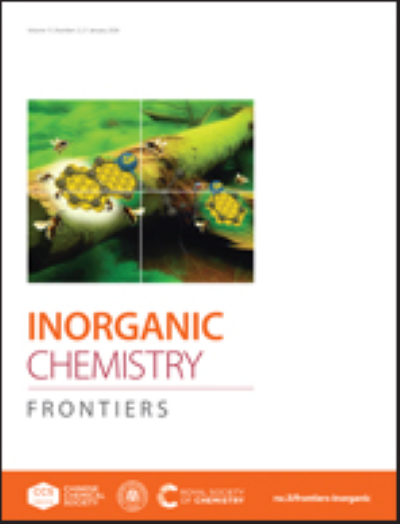Near-Infrared-II Photothermal Conversion and Magnetic Dynamic Synchronous Control in [Ln3Rad2] Aggregate by Rigidity Modification of Nitronyl Nitroxide
IF 6.1
1区 化学
Q1 CHEMISTRY, INORGANIC & NUCLEAR
引用次数: 0
Abstract
Radical-metal compounds as functional materials could apply to multiple fields such as solar-thermal conversion and ultra-high density data storage. However, reactivity and instability of organic radicals usually hamper the development and application of radical-metal compounds. Herein, we utilized persistent nitronyl nitroxide to construct two categories of nitronyl nitroxide-Ln compounds involving a rare [4f-2p-4f-2p-4f] multi-spin motif with electron donor-acceptor pattern. Significantly, the introduction of nitronyl nitroxide effectively recedes radiative transition process and facilitates bathochromic shift of absorption spectrum to endow Dy compounds with precious NIR-II photothermal conversion function. Furthermore, synergistic action of rad-Dy/rad magnetic interactions and strong magnetic anisotropy of DyIII ions bestows single-molecule magnets (SMMs) behavior upon the system. Notably, thanks to rigidity modification of nitronyl nitroxide, prominent enhancement of photothermal conversion efficiency from 56.9% to 74.0% and magnetic switching phenomenon have been observed with molecular structure transformation from flexibility to stiffness, offering an avenue in synchronous control of photothermal effect and magnetic dynamic for the first time.通过硝基氧化物的刚性改性实现[Ln3Rad2]聚合体中的近红外-II 光热转换和磁动态同步控制
作为功能材料的自由基-金属化合物可应用于太阳能-热转换和超高密度数据存储等多个领域。然而,有机自由基的反应性和不稳定性通常会阻碍自由基金属化合物的开发和应用。在此,我们利用持久性亚硝基氮氧化物构建了两类亚硝基氮氧化物-锰化合物,其中涉及具有电子供体-受体模式的罕见[4f-2p-4f-2p-4f]多自旋基团。值得注意的是,硝基亚硝基的引入有效地减弱了辐射转变过程,促进了吸收光谱的浴色偏移,从而使 Dy 化合物具有珍贵的近红外-II 光热转换功能。此外,镭射-镝/镭射磁相互作用的协同作用和 DyIII 离子的强磁各向异性赋予了该体系单分子磁体(SMMs)特性。值得注意的是,由于对硝化亚硝基进行了刚性修饰,光热转换效率从 56.9% 显著提高到 74.0%,而且随着分子结构从柔性到刚性的转变,还观察到了磁性切换现象,首次为同步控制光热效应和磁性动态提供了途径。
本文章由计算机程序翻译,如有差异,请以英文原文为准。
求助全文
约1分钟内获得全文
求助全文
来源期刊

Inorganic Chemistry Frontiers
CHEMISTRY, INORGANIC & NUCLEAR-
CiteScore
10.40
自引率
7.10%
发文量
587
审稿时长
1.2 months
期刊介绍:
The international, high quality journal for interdisciplinary research between inorganic chemistry and related subjects
 求助内容:
求助内容: 应助结果提醒方式:
应助结果提醒方式:


